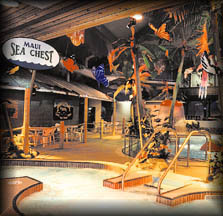

Despite the fact that Europe, during the late 1960's and 70's, had introduced "leisure pools", it was not a concept that was readily accepted in Canada until the early 1980's. With the larger cities tending to adopt an approach of "let someone else try it", it was the smaller, more isolated communities in British Columbia who had the foresight and courage to introduce entertainment in recreation facilities.
Isolated towns such as Tumbler Ridge, Gold River, and Smithers, where winter conditions are extreme, managed to provide innovative, multi use leisure facilities allowing fun, enjoyment, and entertainment within very limited budgets.
A basic "kit" of parts, gradually evolved with the design of these pools. Free form leisure lagoons, saunas, swirl pools, sprays, and moving water, were creatively introduced.
The success of these smaller facilities provided the catalyst for larger cities to seriously consider "entertainment" when building or renovating facilities. Many of these larger pools where driven towards "Competitive Games" when designed and it was important to have a financially responsible "Life After the Games".


Two good examples of such facilities are the 1994 Commonwealth Games Pool in Saanich and the 1993 Canada Games Pool in Kamloops, where greater innovation on a larger scale was used. The leisure pool components incorporated in these facilities offer family use and access for all "after the Games", making them more financially viable.
Traditional pools, prior to the 1980's, were designed primarily with the competitive swimmer in mind. Strictly rectilinear in form, these facilities were designed for competition and training. The recreational swimmer took second place, utilizing these standard "forms". They lacked life, where cold, clinical, uninspiring, and completely utilitarian in atmosphere.
Following the successful introduction of "free form leisure pools", came the development of the "decor pack". A "decor pack" is now deemed essential to provide an exciting, welcoming and friendly environment. Initially this involved basic impact colours or simple multi coloured graphics on the walls.
The introduction of rocks, trees and plants soon enlivened these spaces. Structural columns were transformed with log clusters and rock bases.
Gradually "theming" became an integral part of the "decor pack". This is not new, having proved enormously successful for Disney operations.


Communities with harsh weather conditions, tropical themes were introduced, incorporating lively three dimensional murals, colourful buntings, palm trees, exotic birds, butterflies, etc. Coloured theatrical spotlighting highlighted significant locations.
Other communities adopted themes depicting specific geographical regions, vacation or destination points, such as Bermuda (in Merritt, BC), Florida Keys (in Coquitlam, BC), and Maui (in Vernon, BC). These pools have become, not only a very important part of recreation for all ages, but also a convenient "at home vacation spot"!
A local theme was introduced at Meadowpark Pool in Whislter, BC. This pool complex provides stunning views of the famous mountains and in keeping with this feature, imitations of the local flora, fauna, and trees compliment the interior.
Other facilities have provided educational examples of theming. Saanich Commonwealth Place, depicts Native Indian Art and experiences. Far away in Invercargill, New Zealand, Maori heritage has been integrated with sweeping dioramas of the flora, fauna and local landmarks with superb results.
Moving water is now provided in any number of ways - wave machines, water falls, raindrop bubble beds and pits. Numerous arrays of sprays, weirs and interactive water play devices, initially introduced to provide entertainment and enjoyment, are features, proved to supply many therapeutic benefits.
The elderly, disabled, and infirm are now actively taking full advantage of a massage under the waterfalls and rain drop units. The benefits associated with walking against lazy river jets and a massage in bubble pits for people with heart conditions have become extremely popular. In some communities, patients are now being bussed in from neighbouring hospitals to explore and enjoy the many possibilities.
One of the most popular features in any pool complex is the "wave machine", recreating the natural ocean phenomenon. The mechanics for providing this form of entertainment have become much more innovative.
Creative design can be achieved by providing waves doubling back on themselves and turning corners, or creating turbulence, and splash. This splashing, turbulence, and moving water will always remain the major attraction in any aquatic facility - for all ages.
While it may be the innovative, exciting leisure pool, that remains the main feature in a recreation complex, the inclusion of other amenities compliment i and add to the profitability of facilities, such as snack bars, viewing terraces, fitness centres, aerobic studios, and child minding centres.
Other popular additions include physiotherapy clinics and retail outlets. The combination of an ice arena and swimming pool complex has also proved to be financially successful. Recently introduced to provide a total recreation and entertainment environment has been the dry kiddies play zones, an extremely lucrative source of income.
The future looks even more exiting as new, previously uninitiated marriages of component parts continue to be introduced with great success.
Free form, multi level ice is on its way - following in the footsteps of the free form leisure pool. New combinations of design and technology will provide informality, excitement, amusement, fun, and exercise resulting in much greater community use than in the past
"Keep them entertained and they are bound to come back!" - it's definitely working in the modern day leisure centre.
Vic Davies, MAIBC, RIBA, MRAIC, - Principal of Vic Davies Architect Ltd., Victoria, British Columbia Canada, specializes in design of aquatic and leisure facilities worldwide.